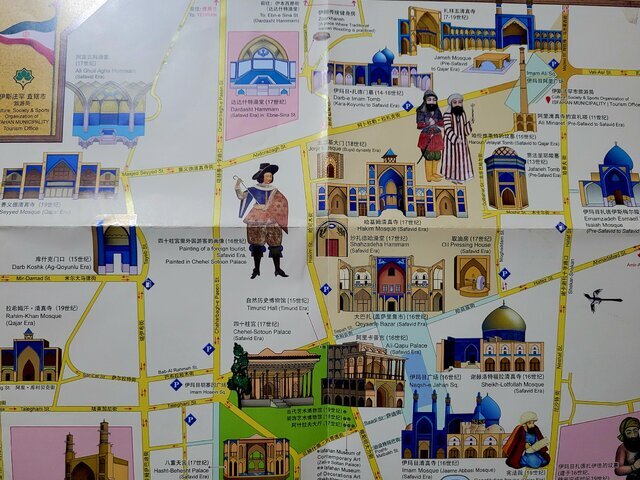Isfahan map dedicated to Chinese travelers unveiled

TEHRAN - A specialized tourism map of Isfahan has been published in Chinese, unveiled at the 17th Tehran International Tourism & Related Industries Exhibition on Thursday.
This unique map, which bears notes in English as well, has been developed with the help of Chinese-speaking tour guides, said Alireza Massah, who presides over the tourism department of Isfahan’s Municipality.
Highlighting distinctive features of the map, the official explained that the design elements, symbols, and colors were chosen specifically to resonate with the tastes of Chinese visitors.
“For instance, miniature art featuring various historical periods was incorporated into the design, along with color schemes appealing to Chinese preferences.”
Regarding the motivation behind publishing this map in Chinese, Massah mentioned the significant influx of Chinese tourists to Isfahan, with approximately 60,000 visitors recorded so far this [Iranian calendar] year.
“A lack of special content to cater to this demographic, prompting the initiative to introduce Isfahan to Chinese travelers through this specialized map,” he explained.
Massah added that while the map is currently available in print format, it will soon be accessible on the Chinese search engine website “Baidu,” providing a digital resource for Chinese tourists.
“Furthermore, copies of the printed map will be distributed to airlines, hotels, and tourism representative offices of Iran in China, facilitating access for Chinese tourists and travelers.”
Moreover, Hamidreza Mohaqeqian, Isfahan province’s tourism chief, emphasized the significance of Chinese tourists as the primary foreign visitors to Isfahan.
Mohaqeqian expressed hope that initiatives like that specialized tourism map would further enhance the experience of Chinese tourists exploring the historical and cultural treasures of Isfahan.
Isfahan, bride of Iran’s tourism
Iran’s tourism minister has said Isfahan is the bride of the country's cultural heritage and tourism. However, it is still unknown to many foreign nationals and in particular potential travelers.
“Isfahan is undoubtedly the bride of Iran's cultural heritage and tourism, so we should introduce it to the world more effectively than before with the help of provincial officials and parliament members,” Ezzatollah Zarghami said last November.
The ancient city, which was the capital of Iran under the Safavids, was once a crossroads of international trade and diplomacy and now is one of Iran’s top tourist destinations for good reasons.
Isfahan is filled with many architectural wonders, such as unmatched Islamic buildings, bazaars, museums, Persian gardens, and tree-lined boulevards. It's a city for walking, getting lost in its mazing bazaars, dozing in beautiful gardens, and meeting people. Moreover, it is renowned not only for the abundance of great historical bridges but also for its ‘life-giving river’, the Zayandeh Road, which has long bestowed the city an original beauty and fertility.
The cool blue tiles of Isfahan's Islamic buildings, and the city's majestic bridges, contrast perfectly with the encircling hot, dry Iranian countryside.
The huge Imam Square, best known as Naghsh-e Jahan Sq. (literary meaning “Image of the World”), is one of the largest in the world (500m by 160m), and a majestic example of town planning. Constructed in the early 17th century, the UNESCO-registered square is punctuated with the most interesting sights in Isfahan.
The square was at the heart of the Safavid capital’s culture, economy, religion, social power, government, and politics. It is hemmed on four sides by magnificent buildings: to the east, the Sheikh Lotfollah Mosque; to the west, the palace of Ali Qapu; to the north, the portico of Qeysarieh; and to the south, the eminent Imam Mosque.
When Shah Abbas the Great became ruler of Persia's Safavid dynasty in 1587, he chose Isfahan as his capital and undertook to make it eclipse all other cities. During his reign, he built so many palaces, mosques, gardens, and bridges that the inhabitants boasted: “Isfahan nesfe Jahan”— “Isfahan is half the world.” The subtle nickname implies that seeing Isfahan is relevant to seeing half the world.
Shah Abbas’s immediate successors continued the beautification. According to a contemporary, Isfahan, a city of 600,000, had 162 mosques, 48 colleges, 273 public baths, and no fewer than 1,802 caravanserais — open courtyards surrounded with buildings, which served as medieval tourist parks where travelers could find water for their camels and food and lodging for themselves.
AFM
